Grillades and Grits - medallions of veal, beef, or pork, smothered until fork tender in a roux-based brown sauce made with the Trinity, tomatoes, and red wine. This rich and comforting Creole dish is perfectly matched with creamy grits and is commonly served for breakfast or brunch, but this New Orleans culinary icon is delicious at any meal. Once you taste Sweet Daddy D’s no-angst recipe for Grillades and Grits, you’ll want to serve it often.
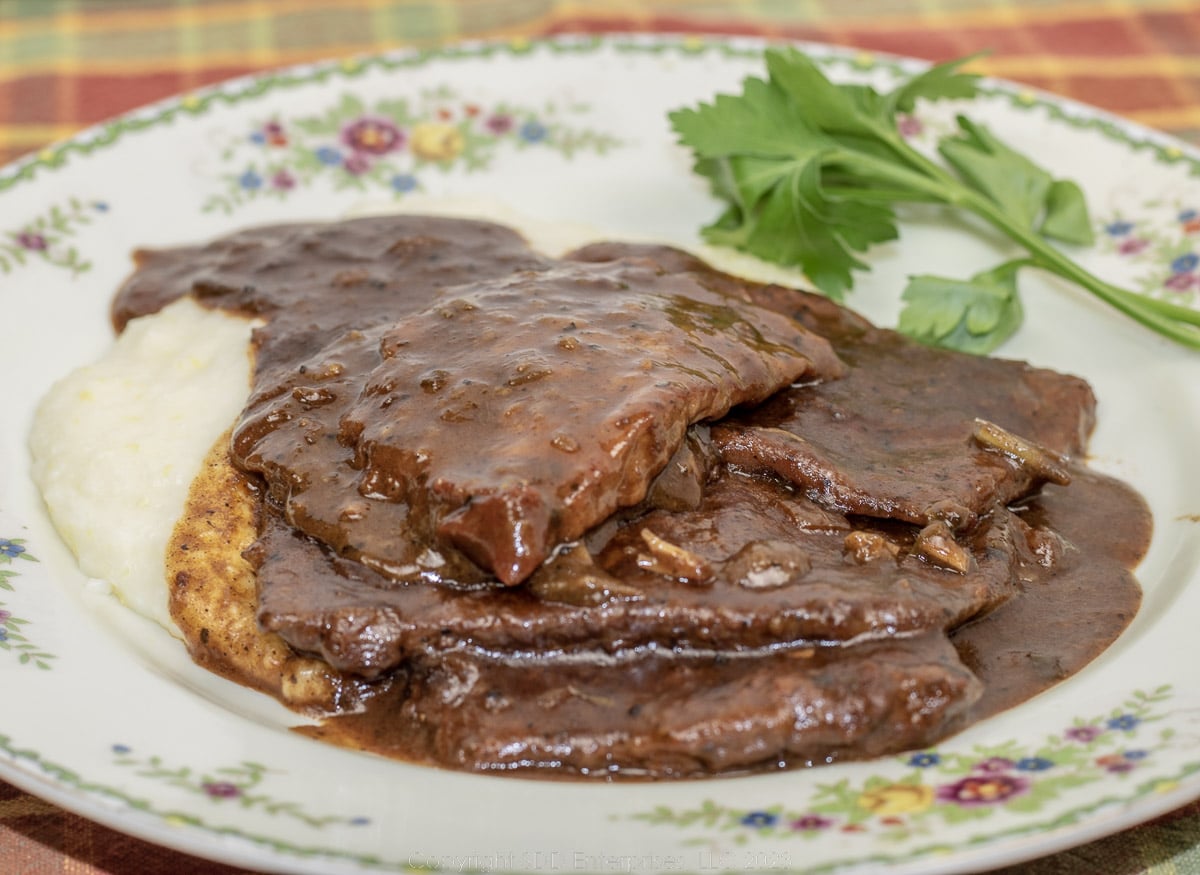
This post is not sponsored, but you will find affiliate links on this page. As an Amazon Associate, I earn from qualifying purchases. The price you pay as a consumer does not change, but I may make a small commission based on your purchase.
If you want to just skip to the recipe, click the "Jump To Recipe" button above or the Recipe link below and you’ll go right there without having to scroll through my article.
Jump to:
What are Grillades?
Grillades are as unique to New Orleans as Red Beans and Rice, PoBoys, and BBQ Shrimp. Pronounced GREE-aahds, the meaning of this French word for "fried" expanded in Creole New Orleans to denote grilled or fried pieces of veal or beef smothered in a roux-based gravy until very tender.
In its traditional presentation, the gravy is fortified with tomatoes and red wine. Paired with grits, they’ve been the highlight of a Creole breakfast or brunch dating as far back as the 1800s. Today, catered events, particularly during Mardi Gras season, feature Grillades and Grits as a centerpiece of their offerings. Although popular at weddings and debutant balls, Grits and Grillades have also found their way to the household table
At its core, Grillades have characteristics common to many Creole and Cajun dishes. A slow cooking method makes it perfect for less expensive, tough cuts of meat, "smothering" or braising them into fork-tender treats. This helps stretch meager resources making them accessible to all economic classes of people. Grits, originally a food common to lower economic classes were a perfect match. However, like many Creole dishes enjoyed by poor or working-class people, it doesn’t take long for them to be relished by the upper classes.
Here’s What You Need
Here are some of the key ingredients for this recipe:

Note on the meat: The term Grillades refers to the method of cooking and not a particular cut of meat. Veal is a more traditional Creole ingredient in this recipe, but beef and pork are also common proteins for this recipe. Check out the Hints and Tips (FAQs) below for more on the types of meat to use.

Note on the Trinity: In South Louisiana, yellow onions, bell pepper, and celery are referred to as the Trinity. This is a common flavor base in many Creole and Cajun recipes.
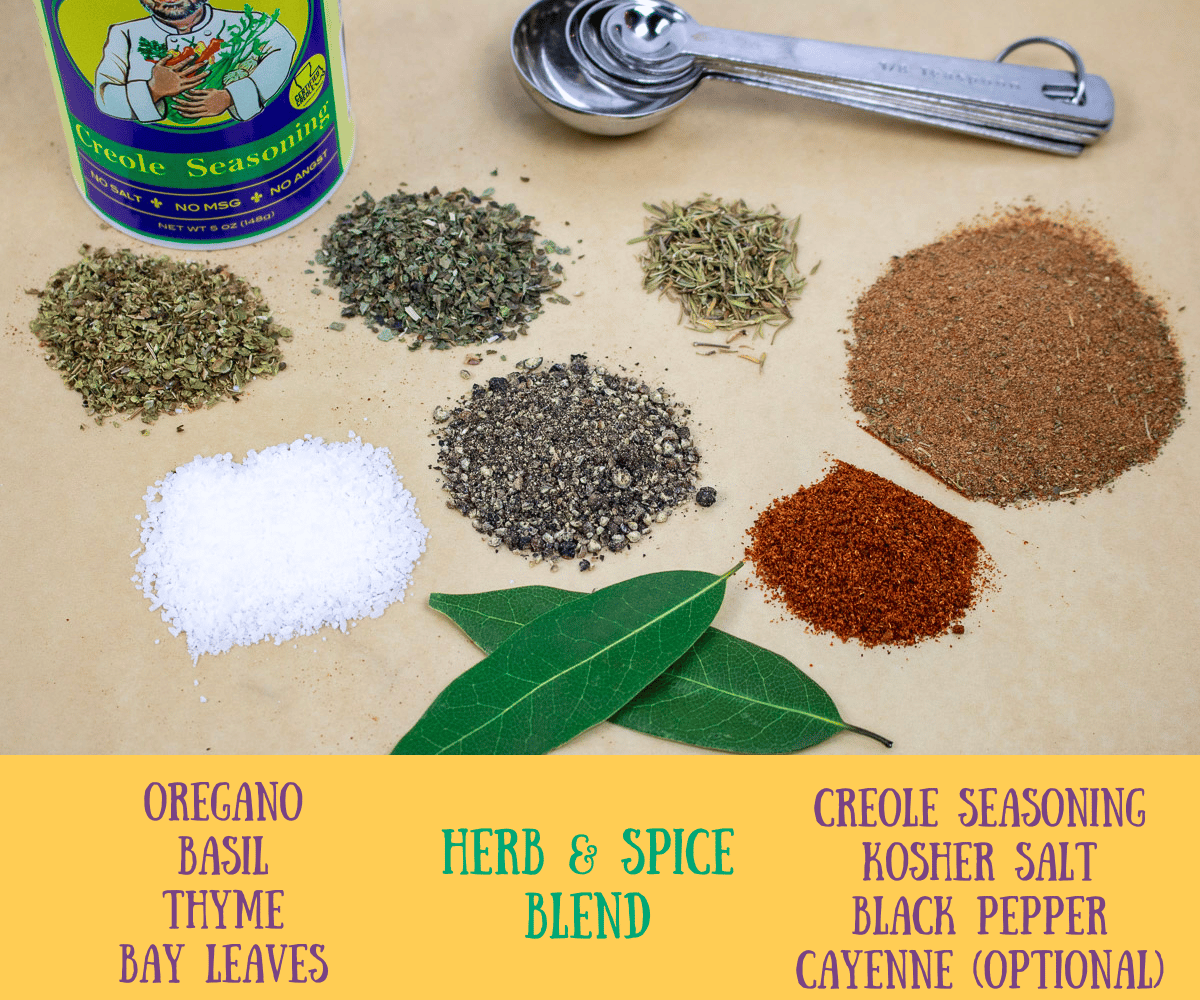

This recipe was developed using Le Bon Papa Creole Seasoning, a no-salt, no-MSG all-purpose Creole seasoning. Created using Sweet Daddy D’s unique recipe, it enhances the individual flavors of your ingredients. Unlike most commercial seasonings, Le Bon Papa does not lay on top of your recipe, it elevates it to a higher level. You choose the amount of salt you want, Le Bon Papa will take care of the rest!
Le Bon Papa Seasonings is approved by the Louisiana Department of Agriculture to display the Certified Creole and Certified Louisiana Logos, assuring that our products represent the heart of South Louisiana.

Note on the grits: For a brunch menu, grillades with grits are a perfect pair. This recipe’s gravy is rich enough to go with plain grits, but I like to use cheese grits for the creaminess and extra flavor profile. If serving grillades for dinner, check out the Hints and Tips (FAQs) Section below for additional options for side dishes.
Note on the cheese: If you are going with cheese grit, Gruyere is a great choice, but you could also use Sharp or Mild Cheddar or Smoked Gouda.
Equipment
Here is some of the equipment I used in making this recipe:
This post is not sponsored, but you will find affiliate links on this page. As an Amazon Associate, I earn from qualifying purchases. The price you pay as a consumer does not change, but I may make a small commission based on your purchase.
Here’s What You Do
First…you have a beer. This recipe will be easy to make if you are prepared. Start with a beer while you read the recipe all the way through. Make sure you have everything you need and that you know what you're going to do with each ingredient and piece of equipment. Then perform your mise en place, so that all the ingredients are laid out for you and all you need to do is assemble the recipe. This also helps assure that you do not leave out any ingredients!
Mise En Place
Prepare the meat:
- Trim the excess fat and silverskin from the meat.
- Cut into serving-size pieces (approximately 3” X 3” or strips).
- Tenderize and pound the meat into ¼” thick pieces.
- Season both sides with kosher salt and ground black pepper
- Set aside while you prepare the remaining ingredients.
Prepare the remaining ingredients:
- Measure the Herb and Spice Blend ingredients and mix them in a prep bowl.
- Chop the Trinity (yellow onions, bell peppers, and celery) and place them in one prep bowl. They do not need to be finely chopped.
- Chop the garlic and green onions and place them in separate prep bowls.
- Place the tomatoes in a strainer over a bowl to drain. Crush the tomatoes by hand, leaving them in the strainer. Reserve the liquid if needed later.
- Measure all the other ingredients and place them in their own prep bowls.
Pro Tip: In preparing the AP Flour, season 1 cup of AP flour with Creole seasoning. Use this to dredge meat, then later use ¼ cup of the remaining seasoned flour for the roux.

Brown the meat
What happens in this step? The depth of flavor we are looking for in this recipe starts at the very bottom. Browning the meat will enhance its flavor, but also leave the fond in the pot. This fond is packed with flavor and will be incorporated into the other ingredients while it cooks.
Add the oil or bacon fat to a Dutch oven over medium-high heat. Dust each piece of meat in AP flour seasoned with Creole seasoning.

Shake off the excess flour and brown them in the Dutch oven for about 2 to 3 minutes on each side. Remove the browned meat from the Dutch oven and set it aside.
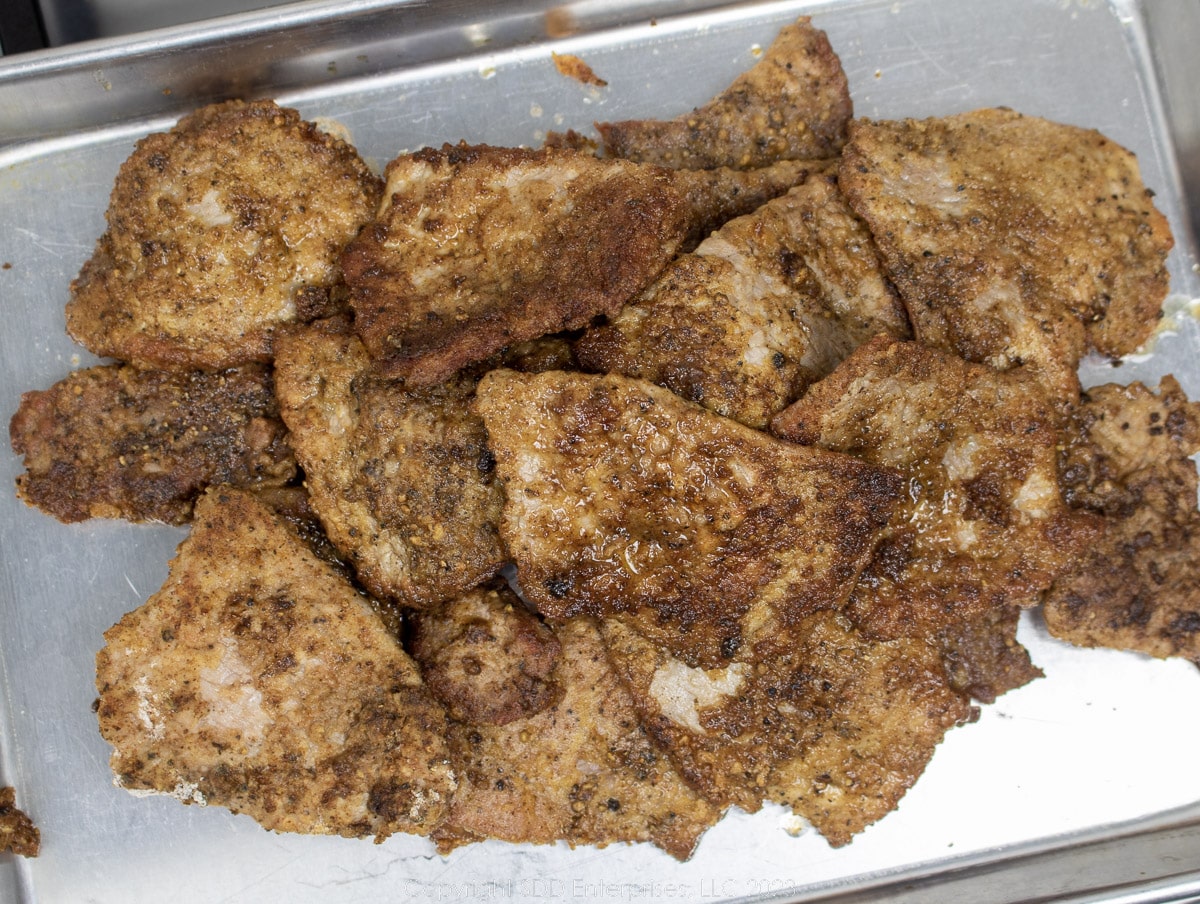
Pro Tip: Browning the meat should be done in batches so you don't overcrowd the Dutch oven.
Saute the Trinity and Make a Roux
What happens in this step? The next layer of flavor comes from cooking the Trinity in the fond created by browning the meat, then cementing the flavor base together with a roux.
Lower the heat to medium and add ¼ cup of butter. Saute the Trinity, constantly stirring, until the onions are starting to caramelize about 12 minutes.
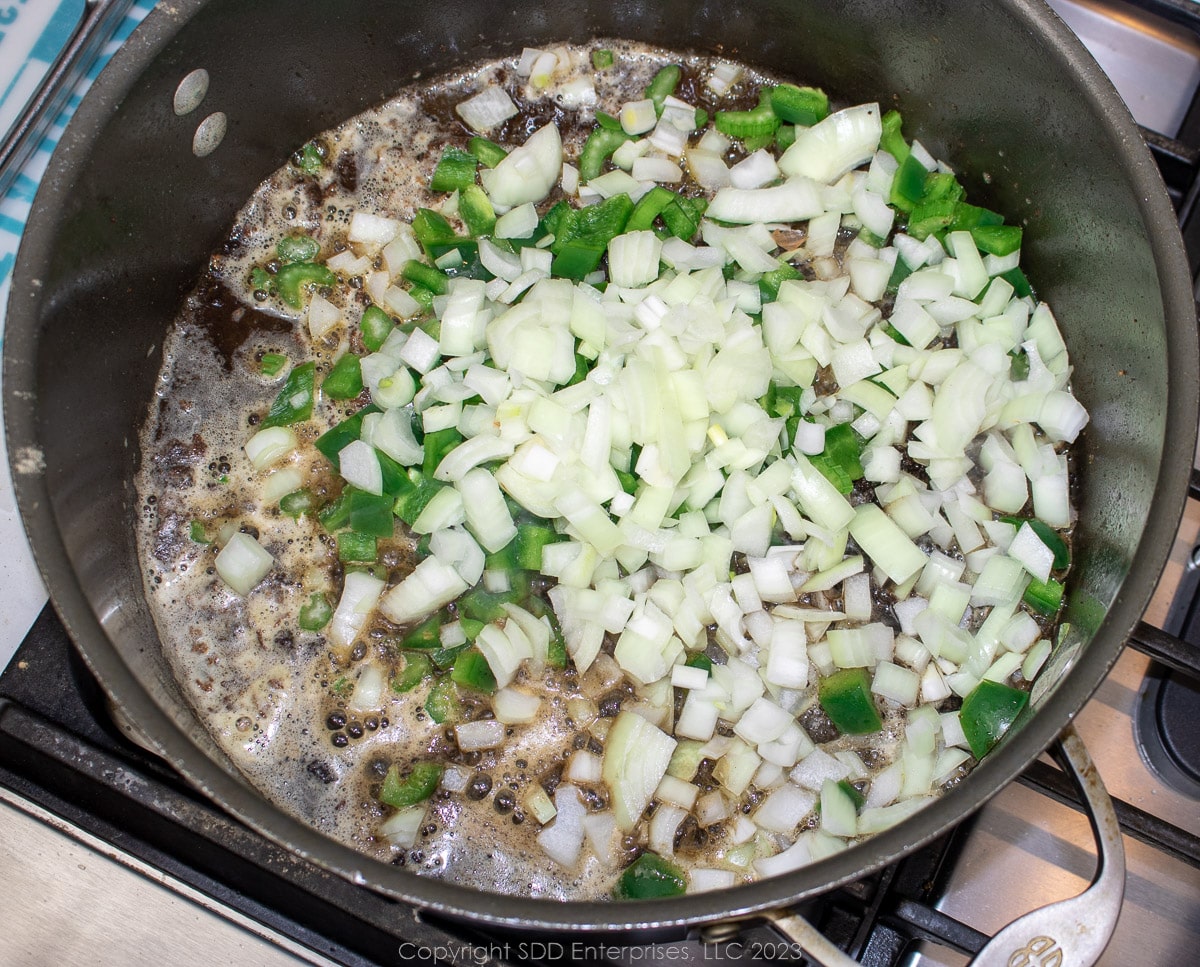
Next, come the aromatics: the garlic, half the green onions, and half of the Herb and Spice Blend (not the Bay Leaves yet) are added and sauteed for about 2 minutes.
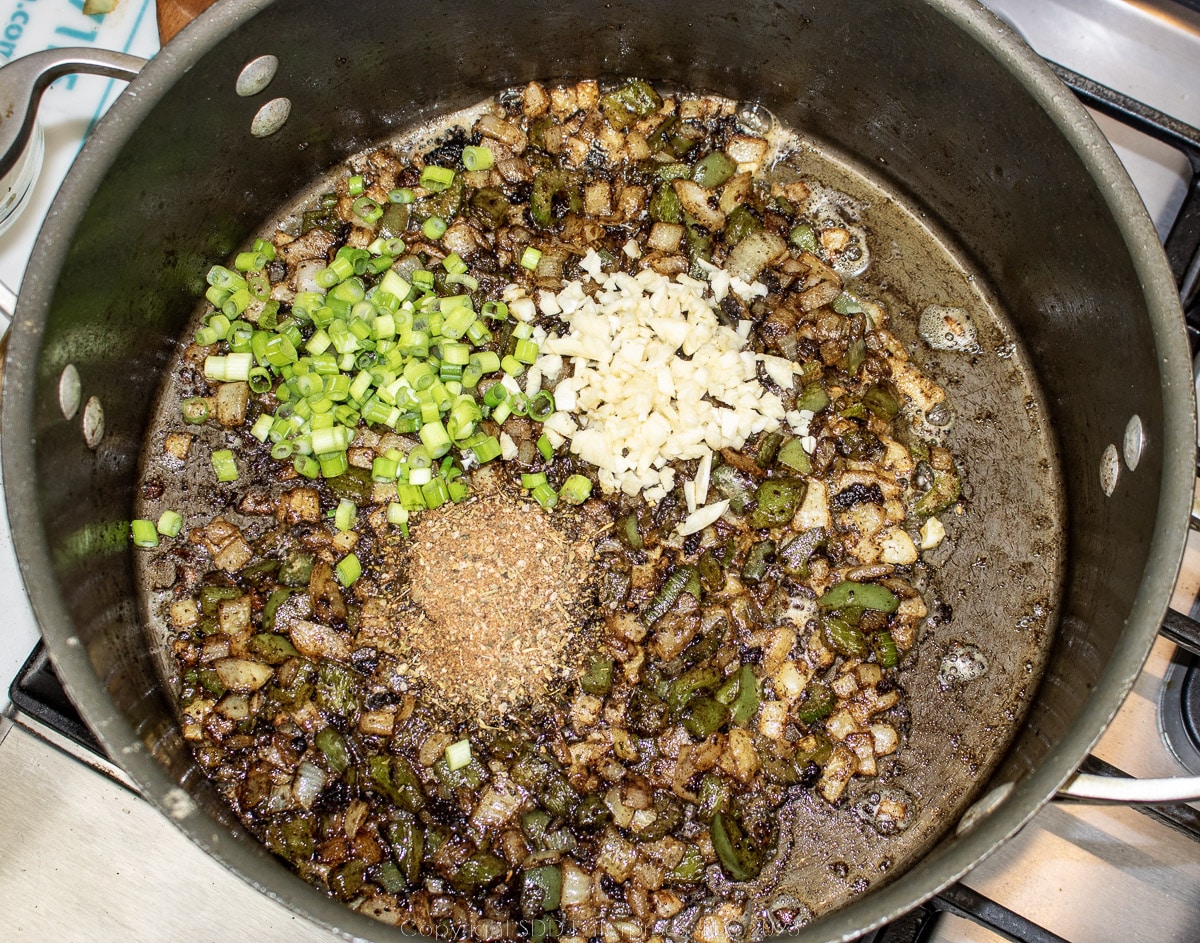
Add the remaining butter. When it is bubbly, add ¼ cup of the seasoned AP flour. Stir constantly for about 3 minutes, until a dark roux is formed.

Note on roux: Usually, when making a roux, the flour is added directly to the fat. Constantly stirring or whisking the flour over the desired heat will eventually darken the flour to your desired color. In this case, we are adding the flour to the fat with the Trinity and aromatics. The flour will absorb the existing color quickly, so you'll only need to cook it until the flour taste is cooked off, about 3 minutes.
Add the tomatoes and wine
What happens in this step? This is the step that makes the gravy unique for creole grillades. We've built a base with the Trinity and aromatics cooked with the fond and fused together with a roux. By adding the tomato paste, crushed tomatoes, and wine in this step, we build a paste that will be the foundation for the Creole gravy or sauce.
To the Trinity/Roux mixture, add the tomato paste. Stir constantly for about 2 minutes.
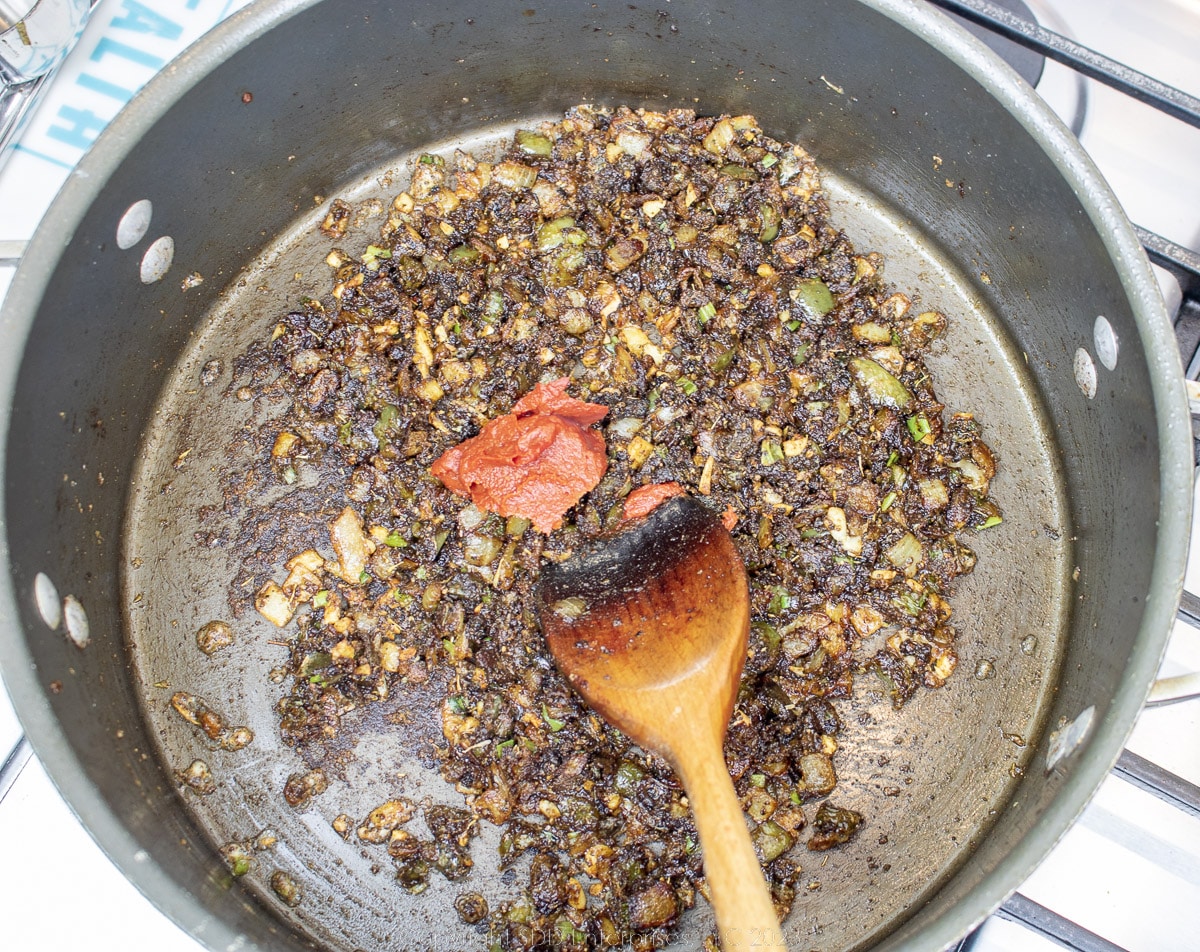
Next, add a little wine to deglaze the pan. Scrape up any fond that has developed in the Dutch oven and stir that into the remaining ingredients.
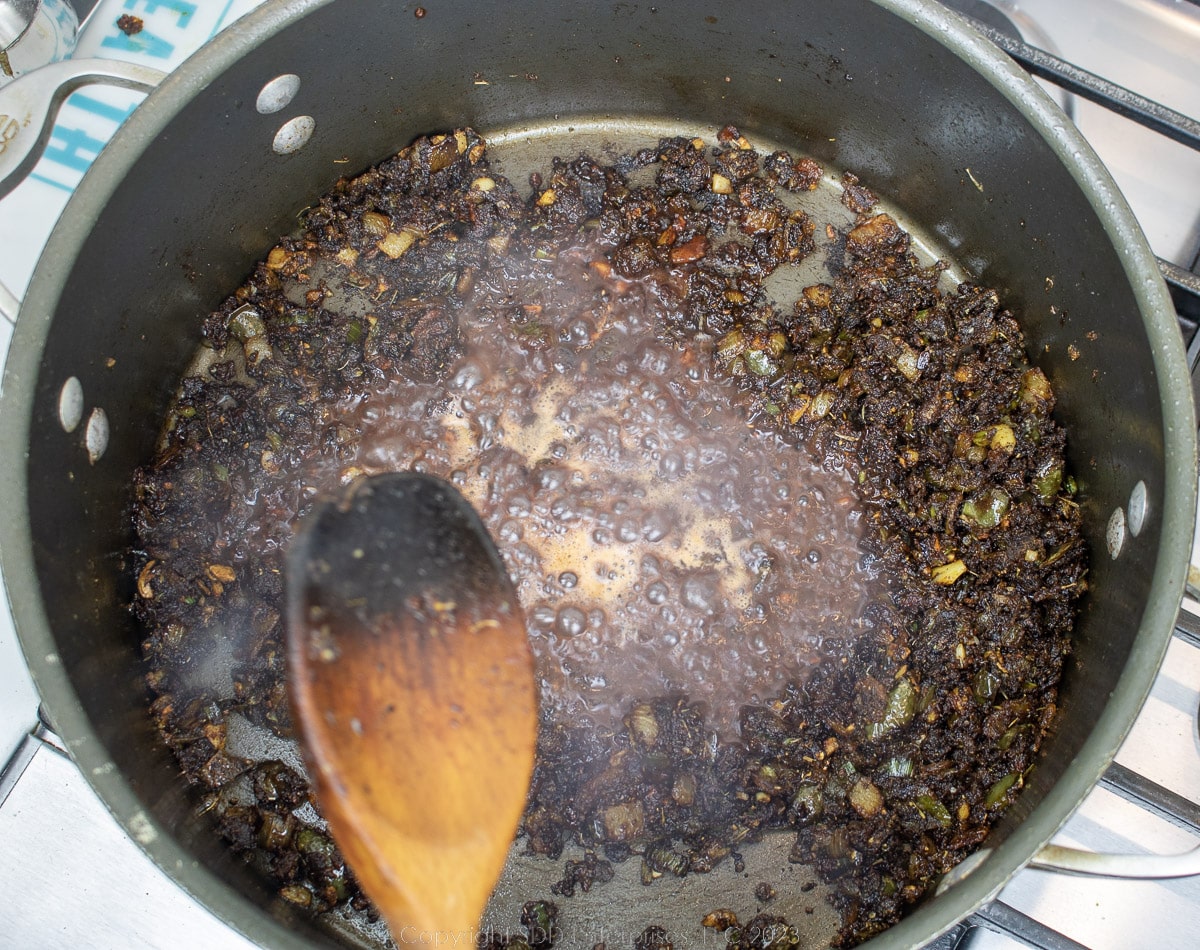
Once this is done, add the remaining wine. Simmer until the wine is reduced by about 50%, which should only take a couple of minutes.

Add the drained, crushed tomatoes, remaining green onions, remaining Herb and Spice Blend plus the Bay leaves, and the Worcestershire sauce.
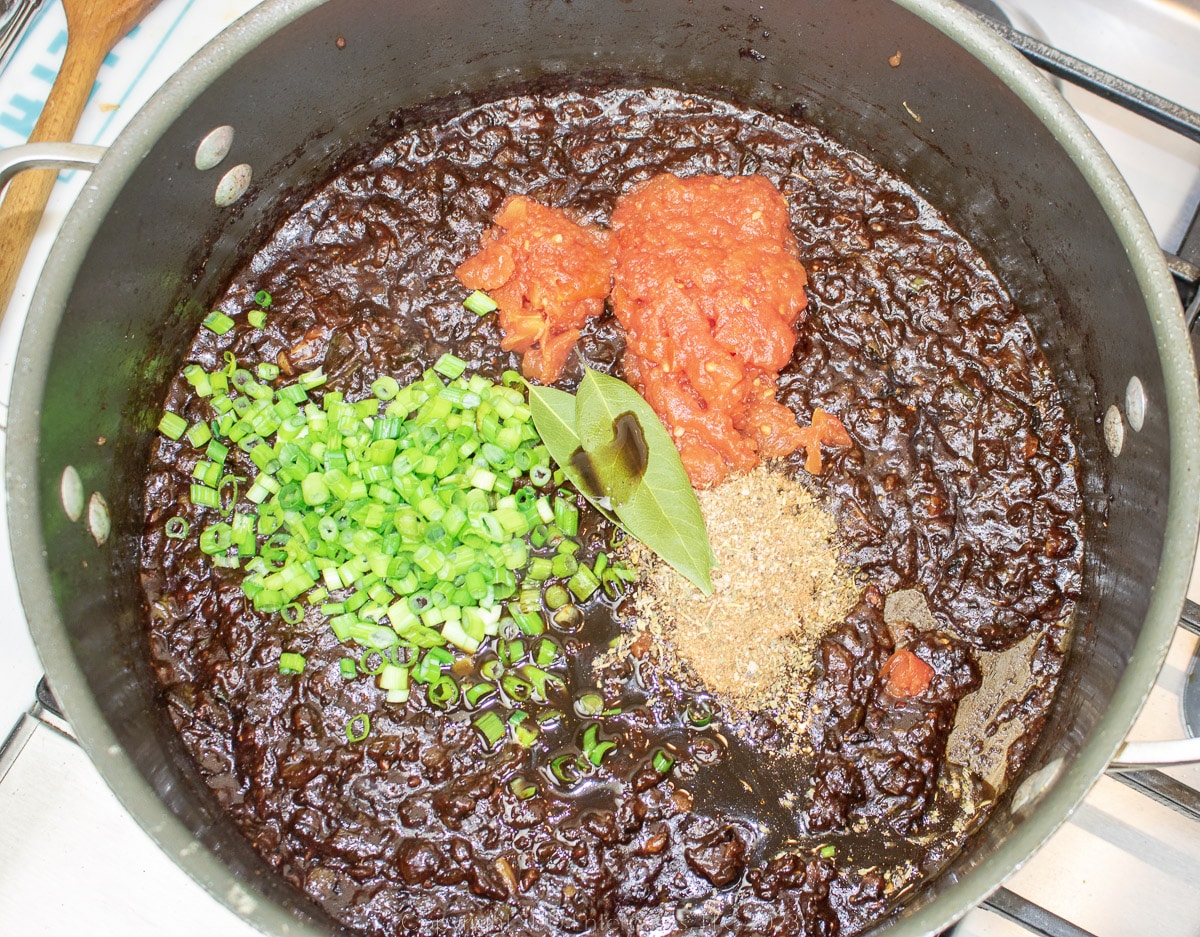
Stir constantly and simmer for about 5 minutes. This should be a thick paste at this point.

Smother the meat
What happens in this step? Now we are ready to smother the meat until it is fork tender. We'll start by adding the stock and the browned meat.
Increase the heat to high. Slowly stir or whisk as you add the stock a little at a time, blending the stock into the roux as you go. Make sure there are no lumps.

Once all the stock has been added, bring it to a heavy simmer for about 5 minutes, stirring occasionally.

Place the browned meat in the sauce. When it's back to a heavy simmer, cover the Dutch oven and reduce the heat to maintain a low simmer for about 1 to 1 ½ hours or until the meat is fork-tender.
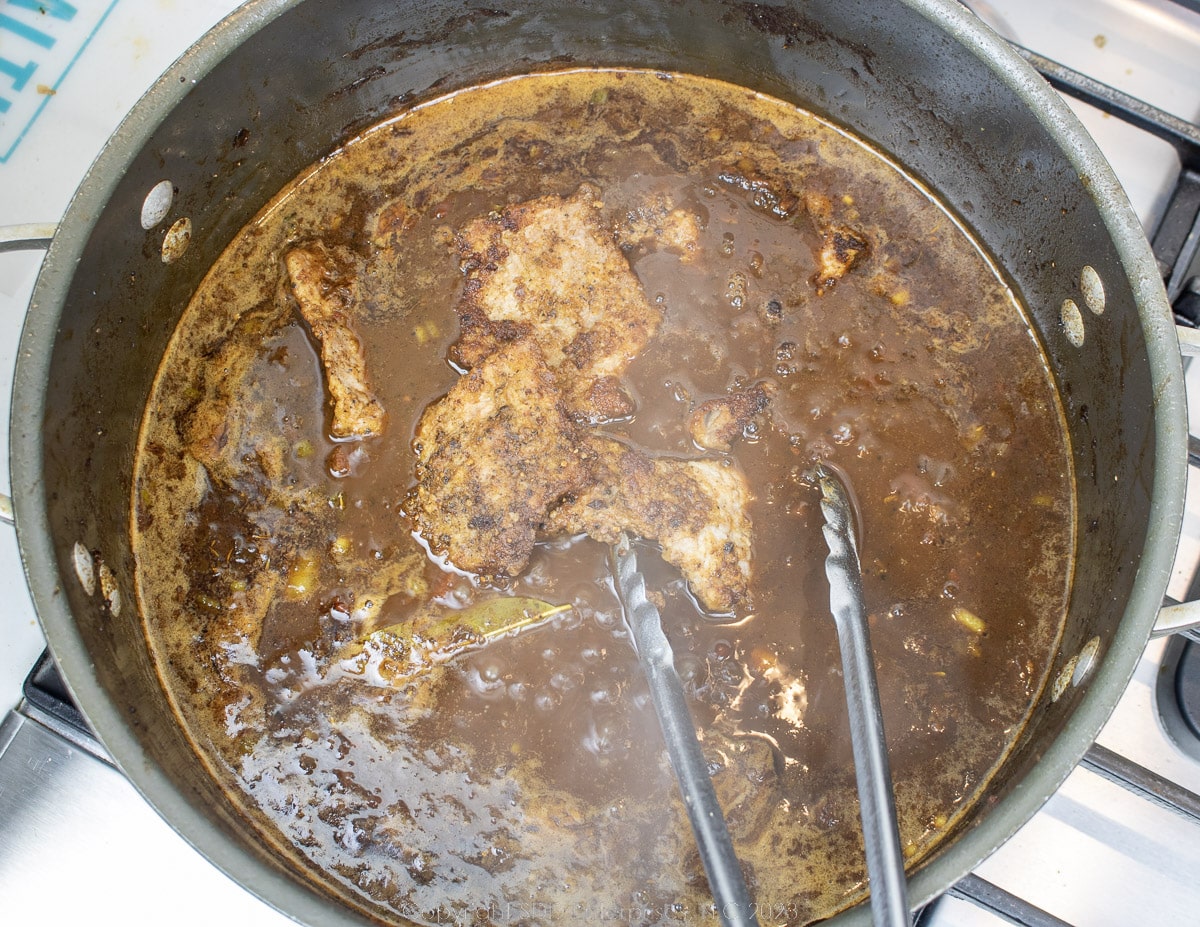
About 30 minutes before the meat is tender, it's time to make the grits.
Prepare the grits
What happens in the step? Cheese grits are simple to make and will add a great dimension to the overall flavor of this dish.
Cook the grits according to the directions on the package. If you are using Old Fashion Grits (as opposed to Instant or Quick Grits), it basically goes like this:
Bring about 6 cups of cold water to a heavy boil. Add some salt then slowly whisk 1 ½ cups of dry grits into the boiling water. Make sure they are all mixed in and there are no lumps.

Pro Tip: Two important things to do when cooking grits: Make sure the pot is covered and the heat isn't too high while simmering. The grits need to absorb all the water to cook properly. The steam will help this process by inhibiting evaporation.
Lower the heat to a simmer and cover. After 7 or 8 minutes, give it a good, bottom scraping stir with a rubber spatula. Cover and simmer for another 7 or 8 minutes (a total of 15 minutes). After 15 minutes, stir it all together, getting all the grits off the bottom of the pan. Add butter.
Pro Tip: At this point, the grits should be fairly smooth with most of the water absorbed. If they are still watery and the grits are hard, put the cover back on and simmer a little longer.
When the grits are al dente, add more butter, ground black pepper, and about 2 cups of grated Gruyere.

Mix and blend until smooth and creamy. Cover the saucepan and remove it from the heat until ready to plate. Whip them up with a wooden spoon or spatula before serving.

Time to serve
When the meat is very tender, taste the sauce for seasoning and adjust as needed.
Pro Tip: Use a fork or a bamboo skewer (preferred) to test the tenderness of the meat.
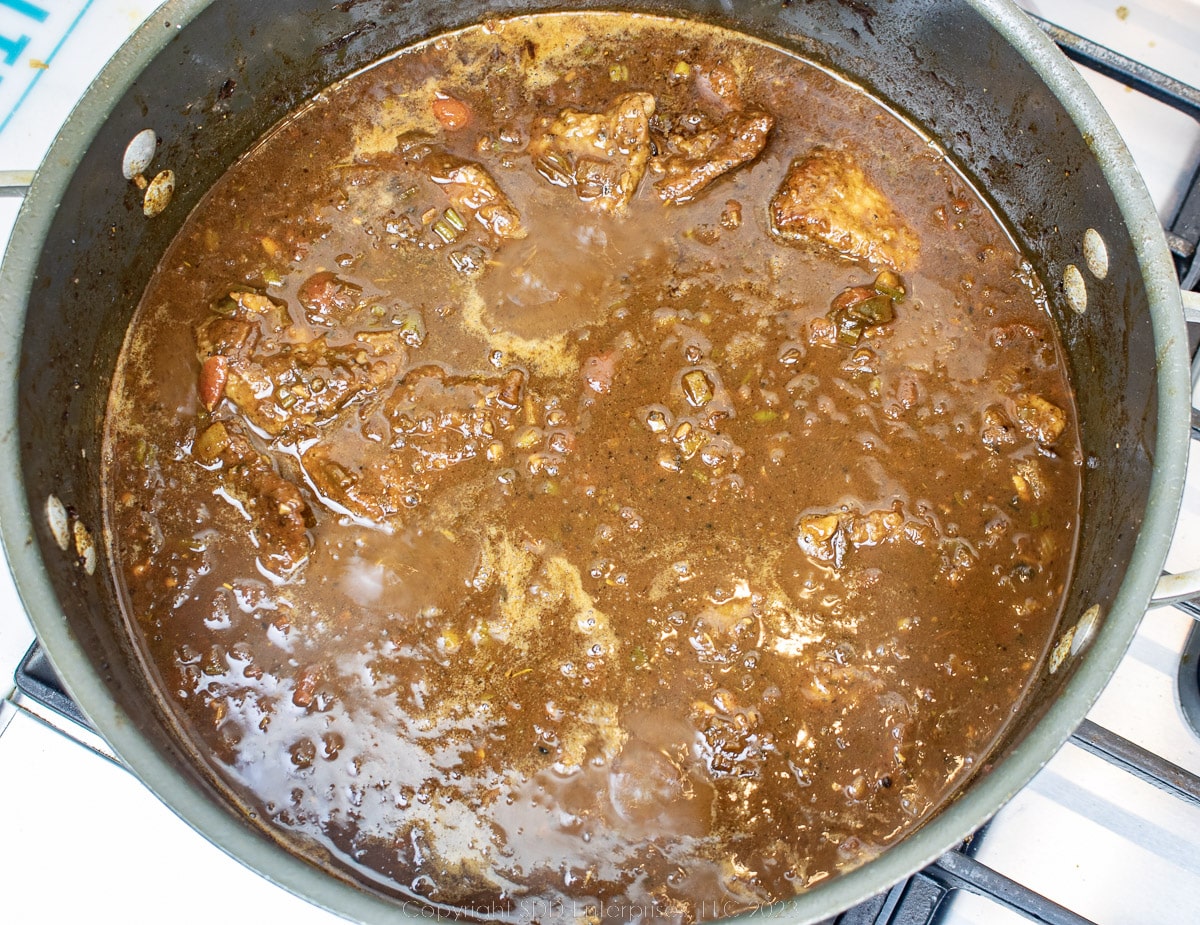
Place about ½ cup of cheese grits on a plate and layer grillades on top. Spoon a generous amount of gravy over it.

Sign up for my email notifications of new recipes and posts right HERE.
Hints and Tips (FAQs)
Grits are a perfect partner for Grillades, even if it's not served for breakfast or brunch. However, if you are not into grits, this goes very well with egg noodles, Spaghetti Bordelaise, Macaroni and Cheese, mashed potatoes, Brabant Potatoes, Twice Baked Potatoes, or even good ole rice.
Leftover Grillades can be kept for 3 to 4 days in the refrigerator if stored in an airtight container. It can also be kept in the freezer for up to 3 months, again if it's stored in a freezer-safe air-tight container. You can store it safely longer than this, but for optimal quality, eat it within this time.
To reheat, defrost in the fridge overnight (if needed), then add the leftovers to a Dutch oven and slowly simmer on the stovetop until it is heated all the way through. You may need or want to add a bit of beef stock or water if the gravy has gotten too thick.
Grits can also be held in the fridge or freezer, but I don't think they work very well as leftovers. If you do save them, mix in a little water and microwave them until reheated. Stir well to regain their creaminess
The term Grillades refers more to the method of preparation than an actual cut of meat. Veal is a traditional Creole presentation of this dish, but it is also delicious with beef round steak or pork tenderloin. Beef is more available and less expensive than veal which makes it a very popular alternative. Pork would have been more popular in Cajun areas where pork was plentiful. The preparation is exactly the same, make sure to pound the meat out to ¼ inch. Make sure to tenderize and season the meat with salt and pepper before dredging in AP flour for browning.
Looking for a side dish for Grillades besides grits? Look no further:
If you make this recipe:
- Tell us about it in the Comments section below
- LEAVE A RATING ON THE RECIPE-worthy of 5-Stars?
- Questions or Comments? that’s the place!
- SIGN UP FOR OUR EMAIL UPDATES so you don't miss anything!
- Post a picture and share it with your friends on our Social Media:
Recipe

Grillades and Grits
Here's What You Need
- 2 Tablespoons vegetable oil or bacon grease
- 2 pounds veal net of bones and trimmed fat
- ½ cup butter divided
- 1 cup AP flour See Notes
- 2 cups yellow onions 2 medium
- 1 cup green bell pepper 1 medium
- ½ cup celery 1 stalk
- 5 cloves garlic 2 tablespoons
- 1 bunch green onions
- 1 cup dry red wine
- 4 cups beef or veal stock
- 2 tablespoons Worcestershire
- 1 tablespoon tomato paste
- 15 ounces whole peeled tomatoes drained
- 2 Tablespoons parsley
Herb and Spice Blend
- 1 teaspoon oregano
- 1 teaspoon basil
- ½ teaspoon thyme
- 1 tablespoon Creole Seasoning plus some to season meat
- 1 teaspoon Kosher salt
- 1 teaspoon Ground black pepper
- 2 Bay leaves
- ½ teaspoon cayenne optional
Here's What You Do
To prepare the meat:
- Trim off excess fat and silverskin. Cut into serving-size pieces (approximately 3” X 3”). Pound to ¼” thick. Season both sides with kosher salt and ground black pepper, and set aside for about 10 minutes.
Make the Grillades
- Add oil to a Dutch oven over medium-high heat. Dust meat in AP flour, shake off the excess, and brown in the Dutch oven for about 2 to 3 minutes on each side. Remove from the Dutch oven and set aside. This may be done in batches.
- Place a Dutch oven over medium heat and add ¼ cup of butter. Saute the Trinity, stirring constantly, until the onions are starting to caramelize about 12 minutes.
- Next, add the garlic, half the green onions, and half of the Herb and Spice Blend (not the Bay Leaves yet) and saute for about 2 minutes.
- Add the remaining butter. When it is bubbly, add ¼ cup of seasoned AP flour. Stir constantly for about 3 minutes, until a dark roux is formed.
- Add the tomato paste and continue to saute for about 2 minutes, stirring constantly.
- Add a little wine to deglaze the pan, then add the remaining wine and reduce it by about 50%.
- Add the drained tomatoes, remaining green onions, remaining Herb and Spice Blend plus the Bay leaves, and the Worcestershire sauce. Stir often until it simmers, then continue for 5 minutes. This should be a thick paste at this point.
- Increase the heat to high. Slowly whisk in the stock a little at a time. Stir vigorously, blending the stock into the roux as you go. Bring to a heavy simmer for about 5 minutes, stirring occasionally.
- Return the meat to the Dutch oven. Bring it to a heavy simmer, then cover and reduce the heat and maintain a low simmer for about 1 to 1 ½ hours or until the meat is fork tender.
- When the meat is very tender, taste the sauce for seasoning and adjust as needed.
- Serve over creamy cheese grits.

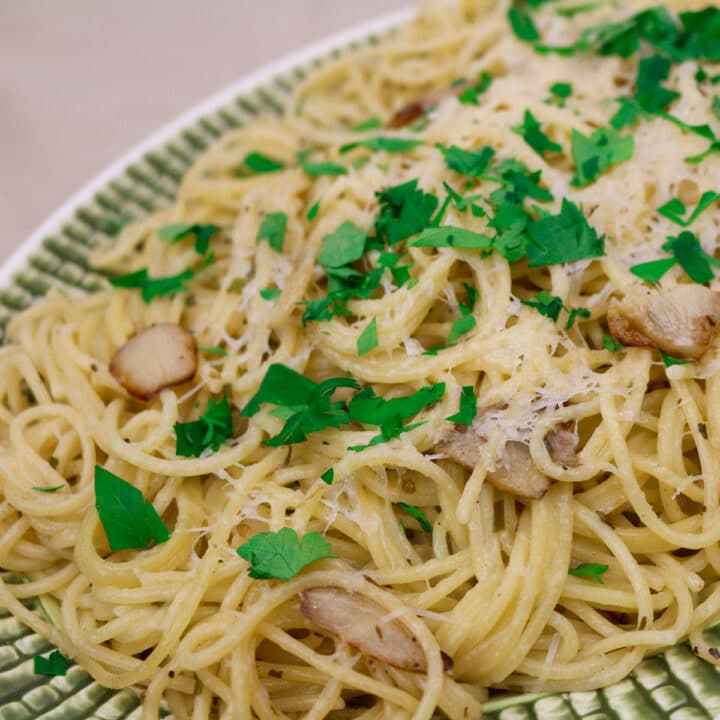


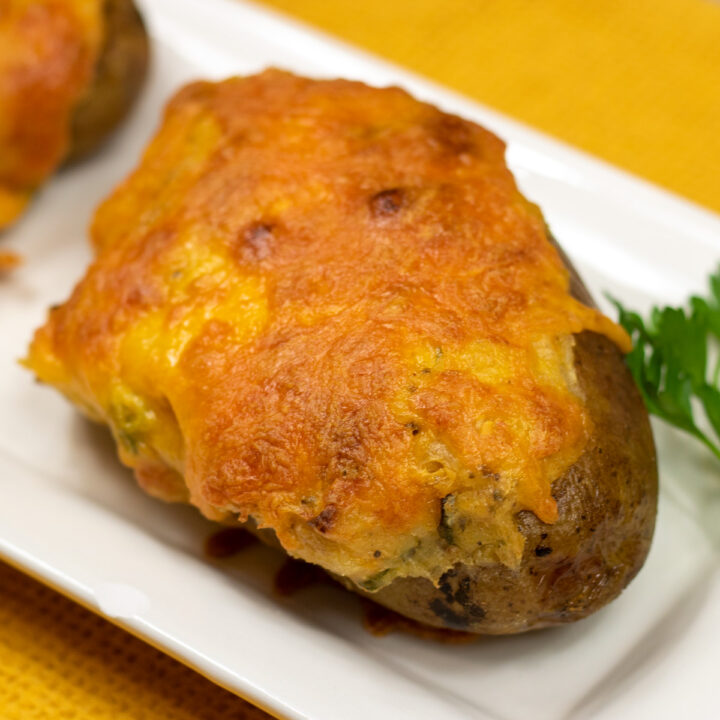
Andrea Houston
I made this tonight using venison leg. It turned out super tender and delicious. Great recipe!
Sweet Daddy D
Yeah you right, Andrea! Thanks for giving the recipe a try and taking the time to let me know. Much appreciated!